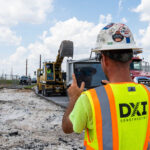Justin Dixon never planned to become Director of Corporate Safety for DXI Construction. But the job fell into his lap in a most tragic way.
Dixon’s parents and grandfather started DXI Construction (formerly Dixie Construction) in the 1960s, and he was in charge of various responsibilities, including marketing, advertising, human resources, and security. An outside company managed DXI’s safety program, and he helped perform site inspections on occasion. But when the man who oversaw safety for DXI died suddenly during back surgery, the task was left to Dixon.
“Overnight, I became the de facto safety guy,” Dixon said. “It was under my umbrella and I knew everybody, so I said until I could find another outside safety company, I would just jump in those shoes for a while.”
But those shoes proved hard to fill. Reviewing the safety information he had received, he realized he was not getting a thorough report of DXI’s safety practices. A snapshot of about 30 visits a month across approximately 150 job sites would not suffice during an audit.
Dixon first hired multiple outside safety companies to cover DXI’s three main locations and 350 employees. He needed someone close enough to respond to a jobsite if an incident did occur.
Those companies helped Dixon identify major safety issues and retrain his employees, but after months of working overnight and sleeping at his desk, he knew he needed more help.
“It was getting harder and harder to rely on the outside companies because I was still only getting a snapshot,” Dixon said. “I could count on them if I picked up the phone and said, ‘We had an injury, can you be there?’ They gave me everything I needed for one incident, but then they were gone again. They weren’t married to the whole situation.”
So Dixon hired James Modafferi as safety manager to build site-specific safety plans, visit jobsites, and run the safety program’s daily operations. Modafferi ensures employees wear PPE and take preventative measures in the field, while Dixon takes care of the paperwork.
That task has gotten more complicated over the years, with job owners asking for more paperwork and more information than ever.
“We get a lot of our work based on our production and reputation, but if you don’t have a safety culture, they’re not even going to look at you anymore,” Dixon said. “To even look at a job you have to prequalify for it, and then to bid the job you’ve got to give them even more information. Once we get the job we have to come up with site-specific safety plans, activity hazard analyses, and job hazard analyses, and you’re in charge of the safety of every crew member you have on that job.”
To compile and track all that information, Dixon and Modafferi have implemented HCSS Safety to add to DXI’s full suite of HCSS software. HCSS Safety keeps track of safety meetings and inspections, allows employees to report incidents and near misses, provides more than 2,500 toolbox talks, safety inspections, and JHAs, and tracks skills and certifications.
Dixon said the fast pace of jobs and the quick turnaround of information led him to research the program.
“We had cobbled together all the same things that we’re getting with HCSS Safety, but we had done them on spreadsheets and binders,” Dixon said. “The safety app is nice because it takes all the binders and folders and file cabinets and scribblings and channels them into a place where we can retrieve them.”
Modafferi said his employees in the field have already taken to using the new system. Safety meetings are the most popular feature.
“I’m trying to find a way to make sure they use it,” he said. “With HeavyJob, they don’t get paid until they enter their time cards. That’s the carrot and stick. I’m thinking they can’t get paid until they do a toolbox talk for the week or they do inspections for the week, so they will have to use it.”
DXI employees use iPads to access Safety on the HCSS Field mobile app, and the new technology is actually exciting to some. Dixon said it shows prospective employees that DXI is embracing innovative ideas and that the company is one at which they can have a long-term career.
But for Dixon, the technology is more about security.
“I learned a long time ago that you always train someone else to do your job because you have no idea if you’re going to be here next week,” he said. “Tomorrow is a gift that is promised to no one. But the show will go on.”
“If you don’t have a safety culture, project owners are not even going to look at you anymore.”
DXI CONSTRUCTION OVERVIEW
• 3 locations
• 350 employees
• 1 safety director
PROBLEM:
• Brought in outside safety companies for help
• Hard to rely on outside consultants, only getting “snapshot”
• Consultants are only there when called, not “married to situation”
NEED:
Software to compile & track all information required to prequalify & bid a project such as:
- Site specific safety plans
- Activity hazard analysis
- Job hazard analysis
- Crew member safety
ENTER HCSS SAFETY SOFTWARE:
Track & compile all of their safety information including:
- Safety meetings & inspections
- Employee field reporting for incidents & near misses
- 2,500+ Toolbox Talks, Inspections, and JHAs
- Track skills & certifications
PROBLEM SOLVED:
“We had cobbled together all the same things that we’re getting with HCSS Safety, but we had done them on spreadsheets and binders. The safey app is nice because it takes all the binders and folders and file cabinets and scribblings and channels them into a place where we can retrieve them”
